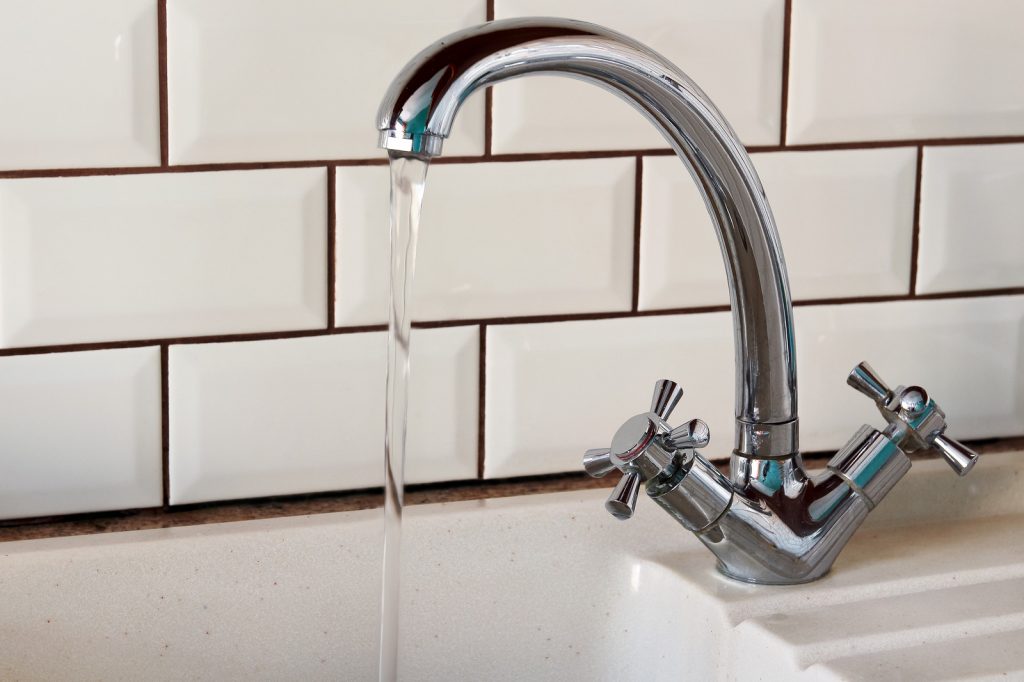Diagnose water pressure drop by first checking if any valves have been turned. This can happen after plumbing work is carried out and valves were turned off, but not turned fully back on. This is the most common cause of a sudden water pressure drop in the house.
We will look at this and other causes below.

Causes of low water pressure in the house
There can be many causes of low water pressure and water flow, sometimes, even when there is no fault to be rectified. Some of the causes are:
High demand for water in the area
You find this during busy morning and evening periods when people are getting ready for work and school, and straight after coming back home.
During dry periods of the year
When people use more water to water gardens, clean cars more often and do outdoor recreational activities in the garden such as filling pool baths etc.
Mains supply leaks
Mains supply pipes can be accidentally broken and have leaks or blockages that affect the water supply to the area.
Height of your property
Properties that are located on the higher slopes or at the top of hills or inclines. These can be affected with pressure drops more often, especially during high demand periods.
Blocked pipes
Internal water pipes made from flexible pvc rather than copper or steel water pipes may have kinks in them or blockages. This will restrict the flow of water to your taps
Clogged taps and faucets
Faucets and taps that have aerators installed may have clogged up with limescale and dirt. You will normally find this on the most used tap in the house. Check the flow rate at the other faucets.
Pipes too small
On many occasions, to keep the installation costs down, installers will use smaller pipes. When more than one tap is opened at once, water flow will drop to one or both the taps. So the diameter of the internal pipes needs to be increased, although this can be expensive.
The stop tap not fully open
If they are located in kitchen cupboards, The main stop tap can be knocked by other items which restricts the flow. Or after work has been done on the plumbing in the house.
Length of the supply pipe
If the branch water supply pipe to your property is long, which means your property is at a distance to the mains, this can affect water pressure coming into your house.
What is low water pressure?
The flow of water from your tap depends on the force of water that is pushing through pipes leading to your home. Low pressure results in taking longer to fill things with water such as kettles and tanks. Combi boilers and some showers will not work properly if water pressure is low.
Water pressure to your home can change throughout the day and busy periods can reduce the pressure in the water mains. Water pressure of 0.5 bar is considered low.
Low water pressure can be caused by external issues with the mains supply where it’s not strong enough to give a good flow to the top of your house, or internally with clogged water pipes and obstructions restricting the flow of water to taps in your home.
Water suppliers to your home must provide a minimum of 1 bar of mains pressure to your home boundary, which could be the stop valve next to your outside wall. One bar of pressure means enough force to push water to a height of 10 meters.
What is good water pressure?
As the minimum water pressure should be 1 bar, anything above this is acceptable. An ideal range would be between 3 and 4 bar. The more you go over this range, the greater the risk of damaging fittings in pipework leading to leaks. If pressure is too high you may need to get a pressure reducing valve.
Ways to increase water pressure in the house
- Clear the aerators of sink faucets and taps of blockages
- Check stop tap is fully open (turn anti-clockwise to open)
- Check if it affects all cold water taps in your property or just one. It will be an internal plumbing issue if only one tap is affected. Call a local plumber for internal problems
- Check for leaks around the house. Stains on the ceiling or walls may give a clue
- Ask neighbours if they are affected. It may be a local area issue rather than anything inside your home.
- Contact your local water authority to see if there has been a leak on the mains
- Install a water pressure booster pump to the incoming cold mains to give you around 1.5 bar pressure and up to 12 litres per minute water flow rate. This booster pump can work on combi boilers up to 30kW output.
- Fit a water pressure accumulator tank (more details below)
- Upgrade the mains supply pipework from the property boundary
A quick way to increase water pressure in the house is to install a water pressure booster pump. You put it onto the cold water feed pipe and it will increase water pressure to 12 litres/min, which is satisfactory for an improved performance from the combi boiler. If you aren’t confident to install it yourself, call a plumber.

What does an accumulator do?
An accumulator is a tank that stores cold water when demand isn’t high and can be stored even under a cupboard counter. Providing an even higher water flow rate, it is an efficient way to deal with low water pressure and helps increase water flow, but you may still require a booster pump with it. A plumber will need to install it.
If you are looking for a comprehensive home package, Hometree offers customers peace of mind with home care packages for plumbing, drains, boiler and central heating and home electrics all at an affordable monthly or annual cost. Hometree’s aim is to take the stress out of boiler servicing and home maintenance with unlimited call-outs and a 24/7 helpline, as well as a no price-hike promise.
Difference between water pressure and water flow
Water pressure measured in bars, is the force at which water is distributed and this can affect a higher or lower water flow. The water flow rate is the amount of water that comes out of your taps, measured in litres per minute. You can have high water pressure but a low water flow rate.
The water flow rate does not affect the water pressure as this is the force of the pressure coming into your home but a low water pressure can mean a low water flow rate. The flow rate is also dependent on pipework, valves and taps in the plumbing system.
How to measure water pressure and flow rate
The most accurate way to measure water pressure is using a mains water pressure gauge showing bars. It is best done on an outside tap because it is the closest connection to the outside mains. But it can still be measured indoors. Water flow rate can be measured with a weir cup showing litres per minute
For outside taps:
- Attach water pressure gauge directly onto tap making sure correct connection..
- Turn on tap to full
- Check and make note of reading in bars
For indoor water connections
- Turn off all taps, inside and outside in the property
- Attach the gauge to the washing machine or dishwasher cold pipe, or sink taps (as instructed by brand manufacturer)
- Turn on tap to full
- Check and make note of reading in bars
How low water pressure affects combi boilers
Because combi boilers work under pressure and are supplied water directly from the mains, water pressure has a big affect on them. If water pressure drops below a minimum level, say 1 bar, the water flow rate may be reduced or the boiler will not start.
Depending on where the first outlet is when the mains supply comes into your property, if the draw off is before the boiler, low water pressure will mean the boiler is not getting sufficient levels to function properly and your heating and hot water could be adversely affected.
Low water pressure can also be a factor depending on where your boiler is installed. If the boiler is upstairs and you have low water pressure, the boiler will be affected and give a lower hot water flow rate.
*The information in this article should be used for general guidance only and not as financial advice. Full details are on the link in the footer to our disclaimer page. Always discuss your requirements with a competent and suitably qualified professional before undertaking any work.
Affiliate disclosure
Heatology.co are participants in a variety of affiliate schemes which help fund and run this website, visitors who follow our links and purchase a product may earn Heatology.co a commission. The money we make from affiliate marketing costs you nothing but keeps us online, so thank you for your continued support!
